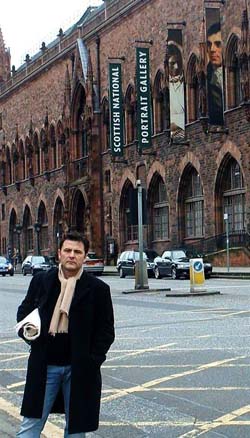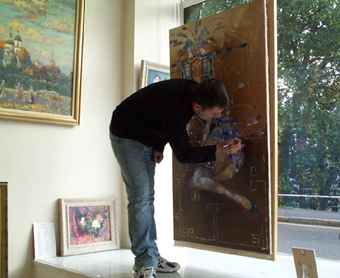|
Timur Akhmedov is an artist from
Uzbekistan. He was born 5 November 1968 in Tashkent. Graduated from
Art College. Since 1990, he is a participant of more than 40
exhibitions in Uzbekistan, England, Scotland, Germany, Russia and a
winner of Grand Prix Asia-Art. His works are characterised by high
tension in the harmony of colour, clear and simple only at first
sight, this art often contains element of implicit symbolism.
Akhmedov's art is an attempt to return
to harmony, both inside oneself, and between oneself and the world,
attempt to find a link with the world, and at the same time to fly
away from it to the better world. His state of mind, generally
characteristic for artists is similar to mediation in prayer.
The special world is enclosed in his
works. His pictures are the result of a creative alloy of the
European art school and Central Asian cultural traditions, where the
clear combination of Asian turquoise, warm ochre and cold red
creates the space of the special musicality.
Timur Akhmedov's works are in many
international private and corporate collections. Collectors include
musician Seal, Dr. M.W.J. Smurfit, HSH Prince Albert of Monaco and
The Kildare Hotel & Country Club, Ireland. Timur is one of the most
exciting and brilliant of the new wave of artists and his
vibrant paintings depict the modern world in all it's extravagant
glory. |
 |
Timur
Akhmedov Ernst
1968 –
Born in Tashkent
 Education Education
1983-87
College
of
Art
of Uzbekistan
1987-90
Academia
of
Art
of Uzbekistan
1998-99
Studio
Royal Academy London
Member
of the Academy of Arts of Uzbekistan
Exhibitions
2013 - Gallery Alif, Dubai
2012 - Theatre Ilhom, Uzbekistan
2011 - Gallery Alif, Dubai
2010 - Theatre Ilhom, Uzbekistan
2009 - Theatre Ilhom, Uzbekistan
2008 - "St. Moritz Art Fest", Swizerland
2008 - Gallery "The Biscuit Factory", New Castle, UK
2007 - London Art Fair, London, UK
2007 - London Art Fair, London, UK
2006 - Gallery "The Biscuit Factory", New Castle, UK
2005 - Contemporary Art Fair, Glasgow, UK
2005 - Cherry Crick Gallery, Oxted , Surrey, UK
2005 - Affordable Art Fair, London, UK
2005 - Artfair, Scotland
2004 - Chelsea Art Fair, London, UK
2004 - CAFE (1ST Contemporary Art Fair), Edinburgh, Scotland
2004 - Marbella Club, Spain
2004 - Maison Du Monde, London, UK
2004 - Gallery "The Biscuit Factory", New Castle, UK
2003 - Gallery "Hay Hill", London, UK
2002 - Gallery "Galina Maxwell", France
2001 - Gallery "Galina Maxwell", Richmond, UK
2000 - Gallery "Peace & Colour", London, UK
1999 - Gallery "Galina Maxwell", Richmond, UK
1998 - Gallery "Galina Maxwell", Richmond, UK
1997 - Asia-Art, Gran-Prix of Bienale, Uzbekistan
1996 - Gallery "Master", Moskow, Russia
1995 - Theatre Ilhom, Uzbekistan
1994 - "Gallery 28", Cork Street, London, UK
1992-94 - Theatre Ilhom, Uzbekistan
 Timur Akhmedov’s Myth Zone Timur Akhmedov’s Myth Zone
 In
the stream of contemporary national art exhibitions held in Tashkent in
the recent decade, the exhibition with Timur Akhmedov’s participation left
a remarkable trace in the souls of both the audience and professionals.
First of all, because Akhmedov’s painting is very singular in itself, it
has a specific artistic language and certain magnetism pulling you into
"communication". Secondly, the exhibitions in question have been a kind of
reflection of the creative creed of the artists and have become colourful
and noticeable events. In
the stream of contemporary national art exhibitions held in Tashkent in
the recent decade, the exhibition with Timur Akhmedov’s participation left
a remarkable trace in the souls of both the audience and professionals.
First of all, because Akhmedov’s painting is very singular in itself, it
has a specific artistic language and certain magnetism pulling you into
"communication". Secondly, the exhibitions in question have been a kind of
reflection of the creative creed of the artists and have become colourful
and noticeable events.
Timur Akhmedov belongs to the generation of
Uzbek artists who on the verge of 80s and 90s, from the very start of
their creative activity have become active exhibition participants. This
period is distinguished by the appearance of associations, communities,
and groups of soul mates who have been taking their own "art niche".
Creative dialogues of T.Akhmedov and his co-workers resulted in the
exhibitions such as "Myth Zone" held in 1991 at Ilkhom theatre, "Standard
Design" in 1994 at the House of Cinematographers, and "Kashmir" in 1998 at
the Museum of Applied Art. These exhibitions did not dwell on any
deep-thought theoretical concepts; they had rather been devised as events
with a generalised idea, as "actions" with often uncontrollable outcome,
as a theatre for oneself and for the others.
The creative manner of the young artist was
already fully established in his early works, and whatever changes
happened in Akhmedov’s creative work, his style retained the originality
of his own visual language.
The artist is thinking in purely painting
categories: colour and its development play the principal role in his
pictures. He creates rich in hues colour combinations with often
transparent borderlines so that only colouristic effects can be perceived.
The relationship between colour reflexes and fractional texture creates
the illusion of motion, because images and objects "placed" in this
environment are overtly static. Usually there is one or two figures in a
composition, "suspended" in the space the reality of which is unidentified
– there is no concrete action, the action is only suggested by an
expressive posture or gesture. The artist makes his heroes live in a set
he has invented himself and brought in accord with the condition and
nature of the character. His paintings show a particular combination of
abstractions and objects, nervous pulse and tranquillity, romanticism and
grotesque.
Timur Akhmedov’s creative work could be
assimilated to philosophic and meditative trend of artistic thought, which
has become specific to the art of Uzbekistan. Artists following this trend
not only reflect upon the aspects of existence, but also express emotions
and spiritual processes such as meditation, prayer, spiritual
enlightenment, and so on; they turn to Oriental philosophies and
religions. What is important for Akhmedov in his works is not the action,
but the emotional inner state of the character in the first place. The
artist employs the traditions of Oriental philosophies not only in the
external drawing and plastic forms, but also in conveying the state of
mind of a character profoundly absorbed in himself. In this regard, a
specific genre of a picture-image can be distinguished. These are the
works "Krishna Tendering the Sacraments", "Saint German, Who Gained Wisdom
in Kashmir", "The Birds", "The Game".
T.Akhmedov has created a series of unusual
portraits ("While They Are Bringing Sake" series, etc.), which speaks of a
certain paradox of the genre. The artist denies his characters’ individual
and personal qualities: he is keen to create a generalised image.
The artist’s view upon the objects of a
still life is quite interesting. He employs primitivistic techniques and
creates exaggeratedly plane images. The objects are deprived of
tangibility, they are given features of something light-weight and even
weightless, and the decorative gracefulness is emphasised.
Akhmedov’s paintings show tendency towards
playing with the form and the models. With the feeling of both irony and
sincere admiration he paints female heads, apparition-like figures,
brightly coloured checkered horse called "St. German’s Horse Carrying the
Instrument to the Shores of Holy India". In almost all of his works the
use of geometric pattern of colour cubes which produces monothematic
effect, has become an interesting device employed by the artist, having
acquired the significance of a universal ornament.
Timur Akhmedov’s paintings are typified by
exquisite form-shaping, subtle decorativeness of colouristic
implementations, emotional sincerity, and irony and a faint smile. These
features put together have contributed to the special style of his
painting.
Akhmedov is credited for a number of
international exhibitions: "The Uzbek Master of Image" in 1994 in London;
in 1999, also in London, held in the Fillip Gallery; on the 2nd of March,
2000, in the Peace & Colour Gallery of London an exhibition was opened
where his works were also presented. In addition, he is a regular
participant of annual exhibitions of Uzbekistan artists at the Central
House of Artists, representing the "Master" gallery.
Undoubtedly, the Grand Prix awarded to the
artist at the international exhibition "Asian Art" held in Tashkent in
1997 was a success. Along with high painting mystery, the jury mentioned
"…a rare lyricism and sincerity" of his works. There are a big number of
creative plans, which lay down the path for his future work. Ten years can
definitely be called a milestone in the life of Timur Akhmedov and the
artist is free to ponder over the results of this period, however, it
would have been more like Timur Akhmedov to remain true to oneself and
treat the date ironically.
Elena Shipovskaya

|
 home
about
artists
exhibitions press
contact
purchase
home
about
artists
exhibitions press
contact
purchase home
about
artists
exhibitions press
contact
purchase
home
about
artists
exhibitions press
contact
purchase